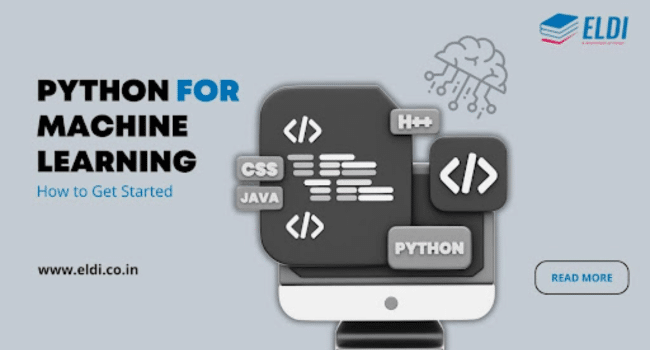Table of Contents
Machine Learning (ML) is transforming every industry worldwide, from healthcare to finance and entertainment to eCommerce. Businesses use ML algorithms to analyze data, predict consequences, and automate decision-making processes. If you find this area interesting, learning Machine Learning with Python would be a viable way to get started.
Because of the easier syntax, the extensive list of libraries, and the enormous community support, Python is the language of choice for ML. If you are a beginner searching for a Machine Learning Course for Beginners or an experienced programmer looking for Advanced Python Machine Learning Training, Python is a good option.
In this guide, we will describe how you can develop expertise in Python for Machine Learning and whether you can enroll in the Best Python Machine Learning Course in Ahmedabad for a better learning experience or self-learn with the help of online resources.
Step 1: Grounding Your Knowledge on Machine Learning Basics
So, before you start coding, it is important to know what machine learning means, which is different from traditional programming.
What is Machine Learning?
Machine Learning is generally a subset of Artificial Intelligence (AI) that allows a computer to learn from data and improve its performance without being specifically programmed.
Types of Machine Learning
- Supervised Learning- The model learns through labeled data (e.g., email spam detection).
- Unsupervised Learning- The model detects patterns in unlabeled data (e.g., segmentation of customers).
- Reinforcement Learning- The model learns through trial and error (e.g., self-driving cars).
Python, with its powerful libraries and frameworks, is well-suited for all three types of machine learning. So, anyone determined to start learning ML can join a Python for Machine Learning course for a guided learning experience.
Step 2: Setting Up Your Python Environment
In order to start working with Python for machine learning, you need to have a suite of relevant tools.
1. Install Python
Download and install Python from python.org.
2. Jupyter Notebook
Jupyter Notebook is an open-source interactive environment for writing and running Python code. This can be installed through:

3. Installing Key Libraries
Some of the important libraries in Python for ML are:

In the Best Python Machine Learning Course in Ahmedabad, you also will come across using PyTorch for Deep Learning, OpenCV for Computer Vision, and NLTK for Natural Language Processing.
Step 3: Basics of Python for ML
Before you dive in to work with ML models, ensure you’re thorough with the basics of Python programming:
- Data Types – Lists, Tuples, Dictionaries, and Sets
- Loops: conditionals – Write if-else statements and use for and while loops
- Functions and modules – Writing reusable code
- Object-oriented programming – Extensions of classes related to objects
All such courses are available at a broader spectrum from platforms like Udemy, and Coursera, or local institutes like ELDI offering the best Machine Learning Course for Beginners.
Step 4: Pandas and NumPy
Data pre-processing is a primary step in ML. Working on large datasets is often crucial.
Pandas Data for Data Analysis

Numerical Operations with NumPy

If you’re in Gujarat and want to learn these skills through hands-on projects, consider enrolling in Learn Machine Learning in Gujarat programs.
Step 5: Data Visualization Using Matplotlib and Seaborn
Data Visualization helps unveil trends and outliers in datasets.

This will be a core highlight of the Machine Learning Course for Beginners. It’s also generally discussed in Python ML courses.
Step 6: Building Your First Machine Learning Model
Now, we can build a basic Linear Regression model to predict prices based on the available historical data.
1. Import Required Libraries

2. Load and Prepare Data

3. Train the Model

4. Evaluate Performance

This initialization is often done in Python ML Training for Freshers before heading on to more complex and tricky ones, like neural networks.
Step 7: Explore Advanced Machine Learning Topics
Once you become adequate in basic ML, you can launch into advanced topics:
- Deep Learning: A more advanced type of neural network using TensorFlow
- Natural Language Processing: Implementing sentiment analysis using NLTK
- Computer Vision: Image recognition using OpenCV
- Reinforcement Learning: A Training Method for AI Using Rewards
These are covered in Advanced Python Machine Learning Training and specialized Python ML Training for Freshers in Ahmedabad.
Step 8: Get Started on Real-World Projects
Working on real-world projects is one of the best ways to learn Python for Machine Learning:
- Spam emails classifier
- Stock price prediction
- Chatbots using NLP
- Fraud detection in banking
The Best Python Machine Learning Course in Ahmedabad provides you with mentor-led projects to hone your hands-on skills.
Step 9: Keep Learning and Networking
It’s an ever-evolving field, so continuous learning should ensure you’re on top of your game.
Some Resources for Staying Current:
- Books – “Hands-On Machine Learning with Scikit-Learn, Keras, and TensorFlow”
- Courses – ELDI, Udacity, Coursera, edX
- Communities – Kaggle, GitHub, Stack Overflow
Learning Machine Learning with Python will aid you with the most up-to-date trends and techniques.
Conclusion: Your Road Map to Mastering Python for Machine Learning
Being proficient in Python for Machine Learning demands effort and increasingly the strength of practice. Here is what you should do to learn:
- Learn the basics of Python.
- Get into data analysis & visualization.
- Train your very first ML model.
- Explore deep learning & AI.
- Undertake real-world projects.
If you feel that expert support would help, then pursuing the Best Python Machine Learning Course in Ahmedabad would make you stride more quickly towards Machine Learning with Python.
